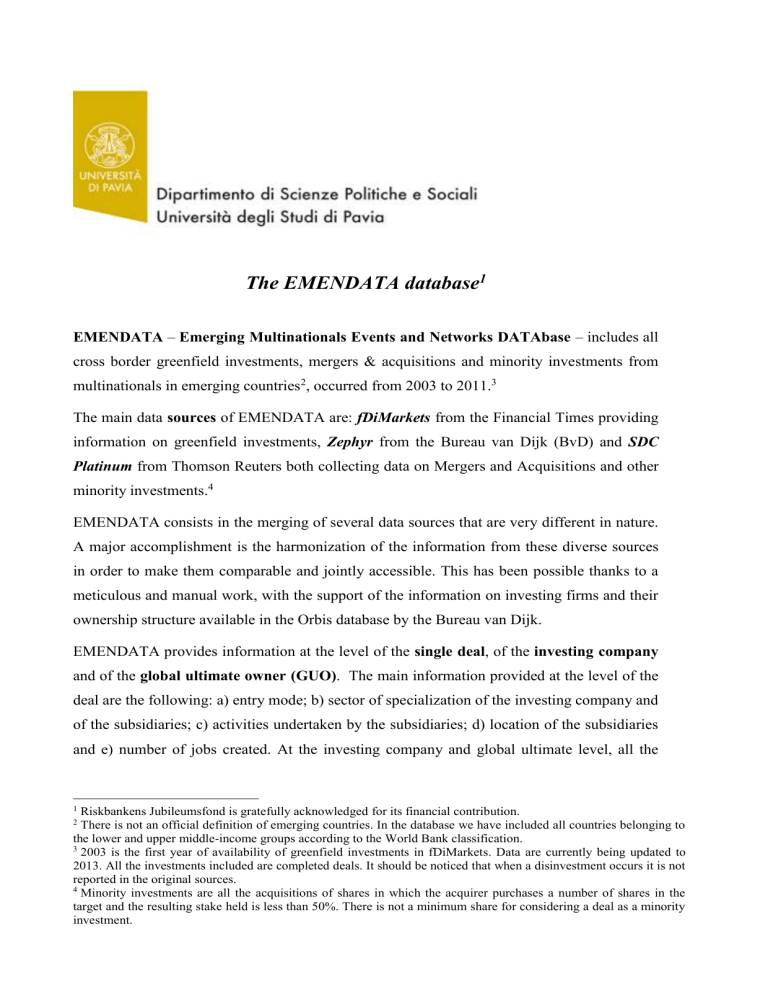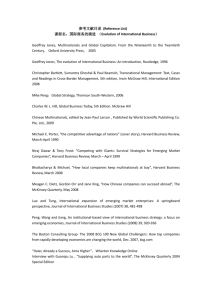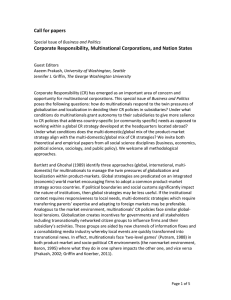Here

The EMENDATA database
1
EMENDATA – Emerging Multinationals Events and Networks DATAbase – includes all cross border greenfield investments, mergers & acquisitions and minority investments from multinationals in emerging countries 2 , occurred from 2003 to 2011.
3
The main data sources of EMENDATA are: fDiMarkets from the Financial Times providing information on greenfield investments, Zephyr from the Bureau van Dijk (BvD) and SDC
Platinum from Thomson Reuters both collecting data on Mergers and Acquisitions and other minority investments.
4
EMENDATA consists in the merging of several data sources that are very different in nature.
A major accomplishment is the harmonization of the information from these diverse sources in order to make them comparable and jointly accessible. This has been possible thanks to a meticulous and manual work, with the support of the information on investing firms and their ownership structure available in the Orbis database by the Bureau van Dijk.
EMENDATA provides information at the level of the single deal , of the investing company and of the global ultimate owner (GUO) . The main information provided at the level of the deal are the following: a) entry mode; b) sector of specialization of the investing company and of the subsidiaries; c) activities undertaken by the subsidiaries; d) location of the subsidiaries and e) number of jobs created. At the investing company and global ultimate level, all the
1 Riskbankens Jubileumsfond is gratefully acknowledged for its financial contribution.
2 There is not an official definition of emerging countries. In the database we have included all countries belonging to the lower and upper middle-income groups according to the World Bank classification.
3 2003 is the first year of availability of greenfield investments in fDiMarkets. Data are currently being updated to
2013. All the investments included are completed deals. It should be noticed that when a disinvestment occurs it is not reported in the original sources.
4 Minority investments are all the acquisitions of shares in which the acquirer purchases a number of shares in the target and the resulting stake held is less than 50%. There is not a minimum share for considering a deal as a minority investment.
existing economic and financial data are included, linking EMENDATA to external data sources (e.g. Orbis).
With regard to firm- and group-level analyses, an innovative feature of EMENDATA is that all the deals included have been linked to firm-level identifiers (both on the investor and on the target company side) as well as to group-level identifiers, therefore consolidating all the deals (both domestic and foreign) undertaken by GUO. Such a coding procedure allows to link up the investors to all the company and group information available in the three original data sources (fDiMarkets, Zephyr and SDC Platinum).
5
Furthermore, the identification of the GUO also allows to link the investing firm to a wide set of information included in BvD Orbis, such as ownership structure, localisation of domestic and foreign subsidiaries, different sectors of economic activity, consolidated and unconsolidated balance indicators, firm size variables; names and types of shareholders and patenting activity. Other possible additional sources of information about the GUOs are FT
Emerging 500, Forbes Global 500, Fortune Global 500 and the EU Industrial R&D
Investment Scoreboard.
Based on the wealth of this information, it is possible to investigate in a very detailed and disaggregated manner the multinational activity of emerging countries’ companies, exploring the intersections of the above-mentioned different dimensions. The information available in
EMENDATA can be disaggregated by deal type or by target countries, by the companies undertaking foreign deals within each group with a disaggregation by mode of entry and geographical destination as well as the sectors of investment and the sectoral disaggregation between the parent company and the subsidiaries.
Below we provide some descriptive tables about the content of EMENDATA. More information can be found in the report Technology-Driven FDI by Emerging Multinationals in Europe . A list of publications using EMENDATA is also included.
We are open to receive proposals for collaborations on research projects using
EMENDATA. If you are interested please send an email to roberta.rabellotti@unipv.it
5 In some cases a manual checking has been undertaken to solve discrepancies among the different sources.
Amendolagine A., Cozza C., Rabellotti, R., 2014, Chinese and Indian Multinationals: A Firm-
Level Analysis of Their Investments in Europe , 27, CIRCLE – Lund University.
Amighini, A. Cozza, C., Rabellotti, R. & Sanfilippo, M., 2014, “ Investigating Chinese Outward
Foreign Direct Investments: How Can Firm ‐ level Data Help ”, China & World Economy,
22(6), 44-63.
Cozza C., Rabellotti R Sanfilippo M, 2014, The Impact of Outward FDI on the Performance of
Chinese Multinationals , BOFIT Discussion Papers 24, Bank of Finland, Helsinki.
Piscitello, L., Rabellotti, R. & Scalera, V.G., 2014, “Chinese and Indian acquisitions in Europe:
The relationship between motivation and entry mode choice”, in Risberg, A., King, D. and
Meglio, O. (Eds), The Routledge Companion to Merger and Acquisition, London:
Routledge.
Piscitello, L., Rabellotti, R. and Scalera, V.G., “ Chinese and Indian M&As in Europe: The relationship between motive and ownership choice ”, CIRCLE Working Paper no. 2014/3,
Lund University.







